Magdalene Visaggio & Claudia Aguirre Wake Up to Morning in America
Main Art by Claudia Aguirre Comics Features Magdalene Visaggio
It would be easy to look at Morning in America and chalk it up as another example of a growing number of nostalgia-fueled stories in decades past. With Stranger Things, Paper Girls, and TV reboots like Heathers and Magnum PI, among others, there’s a growing pool of media set in or revisiting a story that originally premiered in the ‘80s. But not all nostalgia is created equal, and not all stories are either.
Magdalene Visaggio has already earned fans and laudits for her work on titles like Kim & Kim and Eternity Girl, where she displays a knack for weaving compelling adventures into heartfelt, character-driven narratives. Morning in America, out this week from publisher Oni Press, is no different, focusing on four girls from rustbelt Ohio in 1983 as they struggle with normal high-school pressures and fears—and overwhelming terror when kids start going missing from their town.
Claudia Aguirre provides all of the art for Morning in America, from lines to colors, with Zakk Saam on letters. Aguirre also colored both Kim & Kim runs, as well as several other Black Mask titles, so it’s exciting to see Aguirre and Visaggio teaming up again. Her art is realistic without feeling stiff or overwrought, with each character given a chance to show their personality and how they fit into the world. The fashion is pure early ‘80s with pastels, leg warmers and big hair galore. None of the featured girls fit perfectly into the mold that’s been given to them, and they all chafe in different ways. Knowing Visaggio, what appears to be a budding queer romance will prove to be just that fairly quickly. With the Sick Sisters on the case, it shouldn’t be too long before they figure out exactly where all the missing kids have gone, despite the fact that all the adults around them seem intent on pretending that nothing is wrong.
In advance of Morning in America #1, available in comic shops and from fine digital retailers today, Paste exchanged emails with Visaggio and Aguirre to learn more about the series’ ‘80s setting, how the book got its name and the process behind designing a kickass new girl gang.
![]()
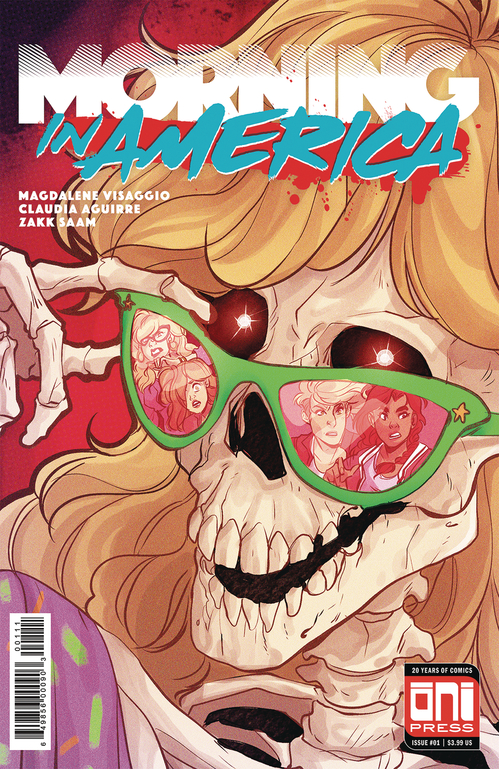
Morning in America #1 Cover Art by Claudia Aguirre
Paste: For anyone unfamiliar with the phrase “Morning in America,” could you give some background? Why pick that as the title for the book?
Magdalene Visaggio: “Morning in America” comes from a 1984 Reagan campaign ad, describing the imaginary paradise his administration had created. I think a lot of people look back on that slogan with a lot of irony; we were still in the middle of a big industrial downturn that we honestly never recovered from, AIDS was ravaging the LGBT population and Reagan was engaging in non-stop nuclear brinkmanship. I guess I liked the irony of a story about the end of the world having such an optimistic title; at one point, the book even included a snippet of the narration from the Reagan spot.
Paste: The setting for Morning in America is fairly specific: a rustbelt town in Ohio in 1983. Why that time and place? Is there a personal connection, or was it more for the context of the story you wanted to tell?
Claudia Aguirre: All my memories of watching TV during the early ‘90s were always about the ”American Dream,” and how everyone could succeed just by being themselves and believing in their dreams. This was the reality I saw from my side of the world, and one that wouldn’t work as well with the fictions and pop culture of the time. In this context, hopelessness and disenchantment from the American Dream are crucial for this story.
Visaggio: I was born in 1984, so the ‘80s feel a bit like a foreign country to me, half-familiar and half-alien. I picked 1983 because it feels like such an unassuming year, but also because it’s a year in which I literally don’t exist. It’s the year before I was born. I hadn’t even been conceived yet.
Tucker, Ohio, in 1983 is a town that’s in the middle of collapse, ready to sip poison while saying it’s wine. That was important to me, to construct an image of powerlessness, of inevitability, of a world that’s utterly doomed. The failing rust belt feels appropriately apocalyptic.
Paste: The art is very specific to that setting, eschewing the ‘80s stereotypes of neon and instead featuring visuals that feel more like Freaks and Geeks or Wonder Years. Was that an intentional choice?
Aguirre: Stylistically, yes. I wanted to convey a slice-of-life kind of vibe for the first bit, because we are thrown directly on Nancy’s daily life (which is, to put it lightly, very bleak) and my approach is a soft, nebulous color scheme.
Visaggio: The bits of the ‘80s I remember are childhood, so that’s the part I wanted to get the closest to. Also, I mean, I do a lot of big ‘80s bombast over in Kim & Kim (which just gets more ‘80s as it goes), and this book was never about flash. It’s about kids and powerlessness.
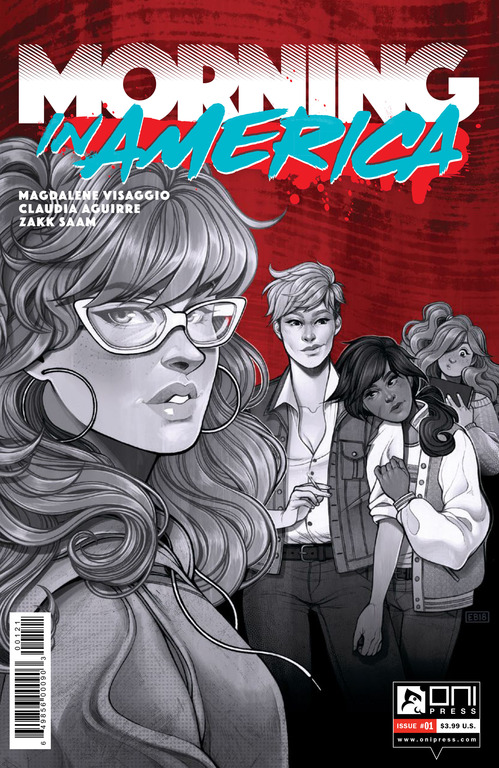
Morning in America #1 Variant Cover Art by Elizabeth Beals
Paste: From the first page, it’s easy to distinguish between the four main characters and understand who they each are as individuals. How did you go about doing the character designs and choosing their clothes?
Aguirre: This was very easy. Mags can breathe life into every single character, and it was simple to nail what we needed on each of the girls. Nancy is our classic ‘80s tomboy, so I took a bit of my own experience in the ‘90s to give her her wardrobe. Veronica is the muscle, she’s big and would definitely break you in half. We decided she’d mostly wear men’s clothes because that’s what fits her. Ashley is a sweetheart but she’d steal your wallet, so I’d have her with her hair covering her eye and freckles. Ellen is like a poisonous animal, her clothes and brilliant makeup showing you she means business. They all have very different approaches to individuality and I wanted to make sure to convey it.
Paste: There’s an undercurrent in the book about female truancy and bad behavior, the fears that set it apart from the same behavior in young men. Was that intentional?
Aguirre: I think we love to live vicariously through rebellious teens. We all wanted to do this. The problem is that these rebellious women in fiction always follow a pattern of being virtuous, and having purpose, instead of just, you know, just exploding against everything aimlessly, giving in to a life of crime. It’s definitely different, especially in the context of Morning in America.
Paste: Along those same lines, though the entire town seems concerned about disappearing children, Nancy decides to get involved when she’s told about a girl being snatched. Do you think that distinction is important?
Aguirre: It’s important, definitely. The system is failing them, the adults are failing them. They can only rely on each other, and I think we can empathize with the hopelessness of not being seen or heard when it matters the most.
Visaggio: It’s important to remember that they’re kids, and their ability to affect the world is limited. They only have the makeshift economies of children: they hang out behind a convenience store; they live off junk food; they ride bikes; they sell cigarettes for a quarter. On top of all that, they live in a dying town and Nancy’s family is in freefall. So she turns to something she feels gives her a sense of power, because all the adults are shirking their responsibilities, from her parents to the authorities. She wants to bring some order to her life. The problem is that she can’t.
Paste: The core foursome are known as the Sick Sisters, which evokes images of Grease’s Pink Ladies and the female drapes in Cry-Baby. Do you have a favorite girl gang?
Aguirre: I don’t have a favorite. We definitely need more kickass girl gangs!
Visaggio: I will always and forever love The Fever from Curb Stomp.
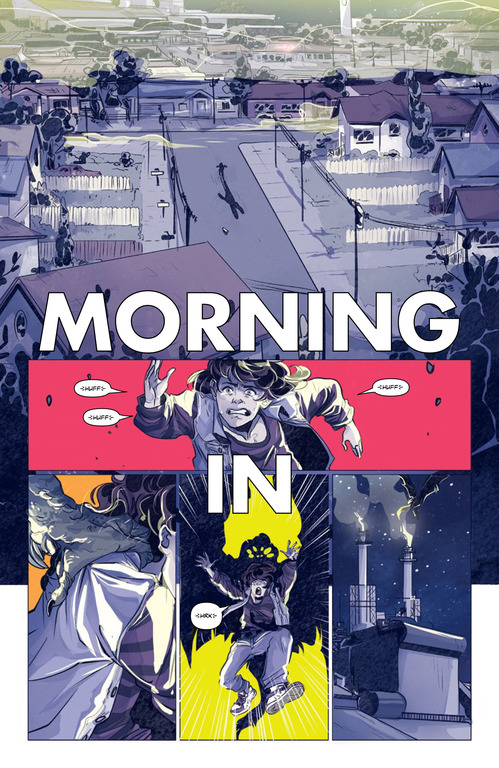
Morning in America #1 Interior Art by Claudia Aguirre
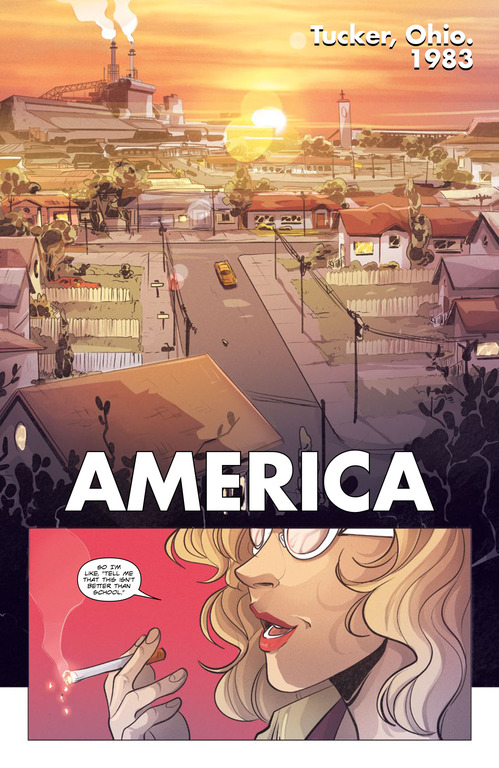
Morning in America #1 Interior Art by Claudia Aguirre
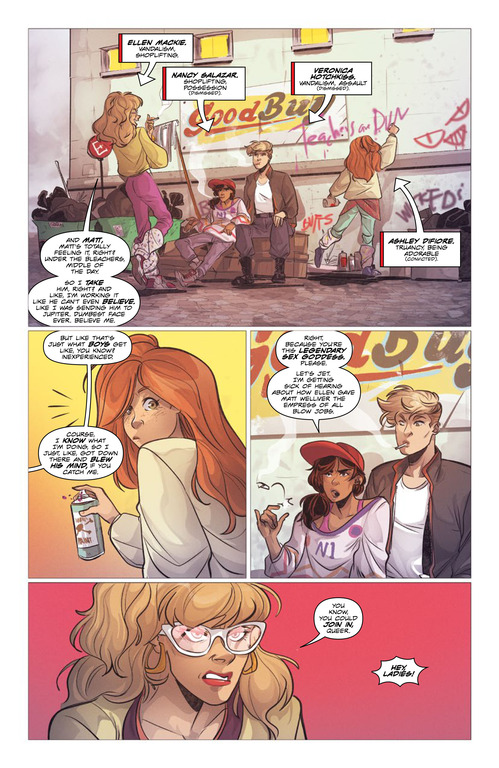
Morning in America #1 Interior Art by Claudia Aguirre

Morning in America #1 Interior Art by Claudia Aguirre
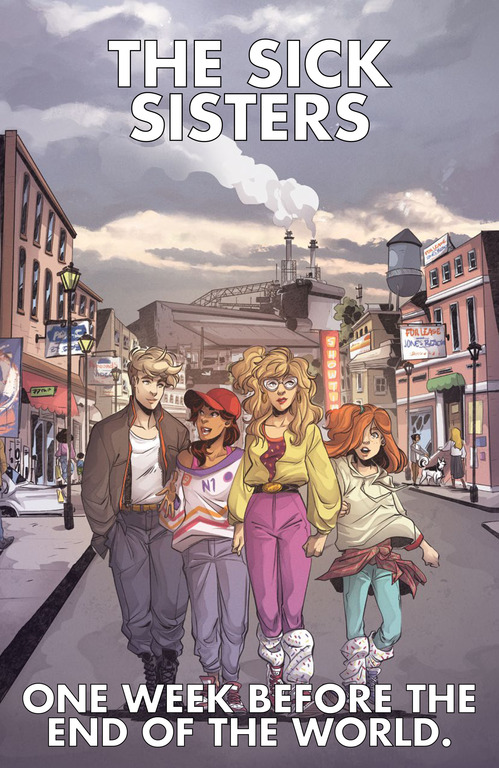
Morning in America #1 Interior Art by Claudia Aguirre
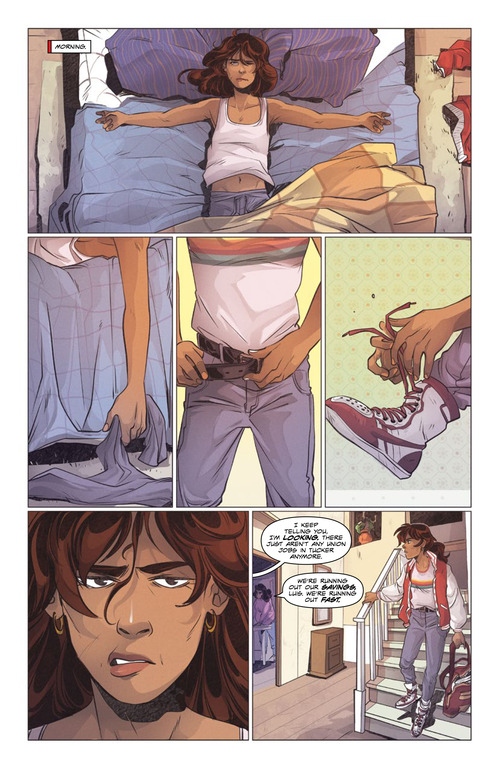
Morning in America #1 Interior Art by Claudia Aguirre

Morning in America #1 Interior Art by Claudia Aguirre